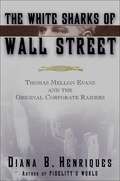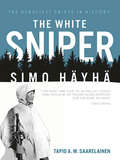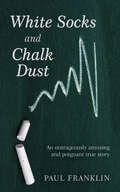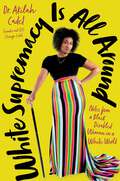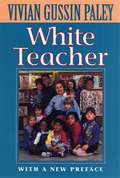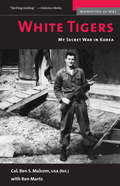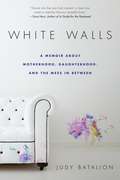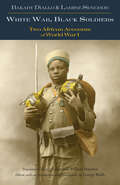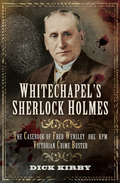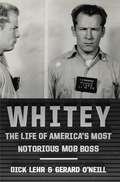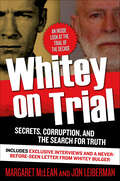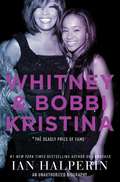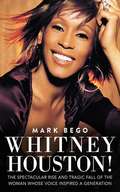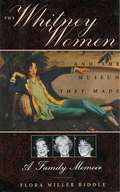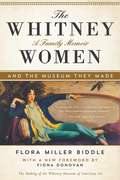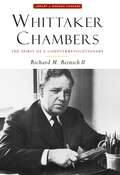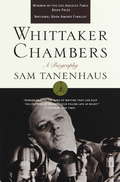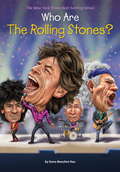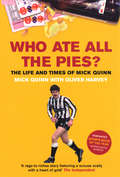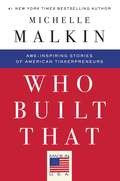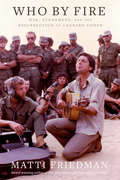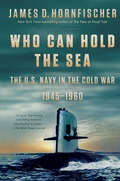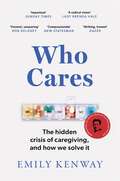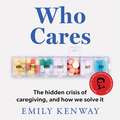- Table View
- List View
The White Sharks of Wall Street: Thomas Mellon Evans and the Original Corporate Raiders
by Diana B. HenriquesIt almost seems that Thomas Mellon Evans was a man so far ahead of his contemporaries that he had moved into the shadows before the full force of his business style had dawned on the rest of corporate America. At every step in his career, he was barging in where few would follow -- at first. But follow they did, at last." -- from the Prologue The first in-depth portrait of the life and times of the trailblazing financier Thomas Mellon Evans -- the man who pursued wealth and power in the 1950s with a brash ruthlessness that forever changed the face of corporate America. Long before Michael Milken was using junk bonds to finance corporate takeovers, Thomas Mellon Evans used debt, cash, and the tax code to obtain control of more than eighty American companies. Long before investors began to lobby for "shareholder's rights," Evans was demanding that public companies be run only for their shareholders -- not for their employees, their executives, or their surrounding communities. To some, Evans's merciless style presaged much that is wrong with corporate life today. To others, he intuitively knew what was needed to keep America competitive in the wake of a global war. In The White Sharks of Wall Street, New York Times investigative reporter Diana Henriques provides the first biography of this pivotal figure in American business history. She also portrays the other pioneering corporate raiders of the postwar period, such as Robert Young and Louis Wolfson, and shows how these men learned from one another and advanced one another's takeover tactics. She relates in dramatic detail a number of important early takeover fights -- Wolfson's challenge to Montgomery Ward, Young's move on the New York Central Railroad, the fight for Follansbee Steel -- and shows how they foreshadowed the desperate battle waged by Tom Evans's son, Ned Evans, to keep the British raider Robert Maxwell away from his Macmillan publishing empire during the 1980s. Henriques also reaches beyond the business arena to tally the tragic personal cost of Evans's pursuit of success and to show how the family dynasty shattered when his sons were driven by his own stubbornness and pride to become his rivals. In the end, the battling patriarch faced his youngest son in a poignant battle for control at the Crane Company, the once-famous Chicago plumbing and valve company that Tom Evans had himself seized in a brilliant takeover coup twenty-five years earlier. The White Sharks of Wall Street is a fascinating portrait of an extraordinary man, whose career blazed across the sky and then sank into obscurity -- but not before he had provided the template for how American business would operate for the next four decades.
The White Sniper: Simo Häyhä
by Tapio SaarelainenThe army guide that taught WWII soldiers how to survive in the jungles and swamps of the tropics.During the Second World War, Allied soldiers fought to survive not only encounters with the enemy but the landscape they found themselves in. Being posted to Southeast Asia and the Pacific to fight the Japanese meant soldiers had to learn to survive in the tropics, fighting and living in endless steamy jungle and perilous swamps. In this alien environment, men had to be able to take care of themselves rather than relying on their unit to supply their needs, something that did not come naturally to the many soldiers born and raised in cities.To help them, the British and US armies produced a number of official training manuals and guides explaining how to identify and fight the Japanese and avoid their deadly punji traps, as well as “jungle lore”: How to find and cook plants that were safe to eat Which animals and insects could kill them How to identify and treat tropical illnesses and diseases How to avoid the dangers of polluted water and cannibalsThe Jungle Survival Manual brings together the official manuals and information that enabled the Allies to fight in Burma, Malaya, Thailand, Indochina, Singapore, and the Pacific Islands—and win the war.Includes diagrams and drawings reproduced from the original guides.
White Socks and Chalk Dust: An outrageously amusing and poignant true story
by Paul FranklinProof that truth is often stranger than fiction, this hilarious and poignant account of the unlikely journey of a mobile soft-drink salesman and sometime band member to school headship, is made still more compelling by virtue of the fact that all events leading up to and during this metaphorical mountain climb are entirely true…
White Supremacy Is All Around: Notes from a Black Disabled Woman in a White World
by Akilah CadetFounder and CEO of consulting firm Change Cadet Dr. Akilah Cadet shares a powerful, incisive look at where we are in the fight to dismantle white supremacy—and what we urgently need to do next.This is the story of how I became an unapologetic Black disabled woman in a white world. This book is for people who look and live structurally like me to be valued, seen, heard and perhaps some advice on how to navigate life amongst white supremacy. This book is also for white people who have been &“doing the work&” since the murder of George Floyd to read my story and be able to clearly see systemic oppression, racism, and ableism. There are books sharing the historical context of white supremacy, providing tips on how to be an ally or anti-racist, and firsthand experiences from Black Indigenous People of Color (BIPOC) which are important. I push the conversation that leads to real change through my story. This book is for the Black woman who is looking to been seen and soft in shared lived experience. It is for the white person who is immersing themselves in the community they want to advocate for. It is for anyone who understands that learning and unlearning is lifelong. White Supremacy Is All Around arrives as the U.S.&’s ongoing racial reckoning has left readers searching for voices they can trust. BIPOC, disabled people, and other intentionally ignored Americans want to feel heard and empowered; organization leaders and allies invested in dismantling white supremacy want a framework for how best to contribute. Dr. Akilah Cadet speaks to all these needs, drawing from her life experiences and work helping leading brands build inclusive and equitable cultures to offer an informed perspective that prioritizes belonging. In a series of personal stories told with her trademark candor and wit, Dr. Cadet explores the long-term work required to combat structural oppression from her unique vantage point as a Black disabled woman. She tackles everything: from the 2020 &“summer of allyship&” and depression caused by workplace discrimination to navigating disability and building a consulting business, all with a little inspo from Beyoncé. A powerful call for true accompliceship for non-Black people, and a way for Black people to see and celebrate themselves, White Supremacy Is All Around ushers in a new voice that is timely, urgent, and essential—and a vision we all need now.
White Teacher
by Vivian Gussin PaleyVivian Paley presents a moving personal account of her experiences teaching kindergarten in an integrated school within a predominantly white, middle-class neighborhood. In a new preface, she reflects on the way that even simple terminology can convey unintended meanings and show a speaker's blind spots. She also vividly describes what her readers have taught her over the years about herself as a "white teacher."
White Tigers: My Secret War in North Korea (Memories of War)
by Ben S. MalcomOperating from a clandestine camp on an island off western North Korea, Army Lt. Ben Malcom coordinated the intelligence activities of eleven partisan battalions, including the famous White Tigers. With Malcom’s experiences as its focus, White Tigers examines all aspects of guerrilla activities in Korea. This exciting memoir makes an important contribution to the history of special operations.
White Walls
by Judy BatalionA memoir of mothers and daughters, hoarding, and healing. Judy Batalion grew up in a house filled with endless piles of junk and layers of crumbs and dust; suffocated by tuna fish cans, old papers and magazines, swivel chairs, tea bags, clocks, cameras, printers, VHS tapes, ballpoint pens...obsessively gathered and stored by her hoarder mother. The first chance she had, she escaped the clutter to create a new identity--one made of order, regimen, and clean white walls. Until, one day, she found herself enmeshed in life's biggest chaos: motherhood. Confronted with the daunting task of raising a daughter after her own dysfunctional childhood, Judy reflected on not only her own upbringing but the lives of her mother and grandmother, Jewish Polish immigrants who had escaped the Holocaust. What she discovered astonished her. The women in her family, despite their differences, were even more closely connected than she ever knew--from her grandmother Zelda to her daughter of the same name. And, despite the hardships of her own mother-daughter relationship, it was that bond that was slowly healing her old wounds. Told with heartbreaking honesty and humor, this is Judy's poignant account of her trials negotiating the messiness of motherhood and the indelible marks that mothers and daughters make on each other's lives.From the Trade Paperback edition.
White War, Black Soldiers: Two African Accounts of World War I
by Bakary Diallo Lamine SenghorStrength and Goodness (Force-Bonté) by Bakary Diallo is one of the only memoirs of World War I ever written or published by an African. It remains a pioneering work of African literature as well as a unique and invaluable historical document about colonialism and Africa&’s role in the Great War. Lamine Senghor&’s The Rape of a Country (La Violation d&’un pays) is another pioneering French work by a Senegalese veteran of World War I, but one that offers a stark contrast to Strength and Goodness. Both are made available for the first time in English in this edition, complete with a glossary of terms and a general historical introduction. The centennial of World War I is an ideal moment to present Strength and Goodness and The Rape of a Country to a wider, English-reading public. Until recently, Africa's role in the war has been neglected by historians and largely forgotten by the general public. Euro-centric versions of the war still predominate in popular culture, Many historians, however, now insist that African participation in the 1914-18 War is a large part of what made that conflict a world war.
Whitechapel's Sherlock Holmes: The Casebook of Fred Wensley OBE KPM, Victorian Crime Buster
by Dick KirbyJack the Ripper and beyond—forty-one years in the investigative career of a man hailed by many as Scotland Yard&’s greatest detective of all time. Fred Wensley was a Somerset gardener when he joined the Metropolitan Police in 1888. His first case was to unmask Jack the Ripper. At least it familiarized Wensley with Whitechapel, where he bided his time collaring less threatening ne&’er-do-wells. After joining the CID, Wensley&’s career was a succession of triumphs. He brought to book the Bessarabian, Odessa, and Vendetta crime syndicates of London&’s East End; he played an instrumental role in smashing Latvian revolutionaries in the notorious Siege of Sidney Street; he formed the Flying Squad, a stealth surveillance team still operating to this day; and most infamous of all—his arrest in one of Great Britain&’s most notorious crimes of passion, a controversial cause célèbre that would shadow Wensley for the rest of his life. Retired Flying Squad officer Dick Kirby has dug deep to paint a fascinating portrait of Fred Wensley, Chief Constable of the CID and the first recipient of the King&’s Police Medal, in this &“welcome biography of a distinguished detective&” (History by the Yard).
Whitey: The Life of America's Most Notorious Mob Boss
by Dick Lehr Gerard O'NeillFrom the bestselling authors of Black Mass comes the definitive biography of Whitey Bulger, the most brutal and sadistic crime boss since Al Capone. Drawing on a trove of sealed files and previously classified material, Whitey digs deep into the mind of James J. "Whitey" Bulger, the crime boss and killer who brought the FBI to its knees. He is an American original --a psychopath who fostered a following with a frightening mix of terror, deadly intimidation and the deft touch of a politician who often helped a family in need meet their monthly rent. But the history shows that despite the early false myths portraying him as a Robin Hood figure, Whitey was a supreme narcissist, and everything--every interaction with family and his politician brother Bill Bulger, with underworld cohorts, with law enforcement, with his South Boston neighbors, and with his victims--was always about him. In an Irish-American neighborhood where loyalty has always been rule one, the Bulger brand was loyalty to oneself. Whitey deconstructs Bulger's insatiable hunger for power and control. Building on their years of reporting and uncovering new Bulger family records, letters and prison files, Dick Lehr and Gerard O'Neill examine and reveal the factors and forces that created the monster. It's a deeply rendered portrait of evil that spans nearly a century, taking Whitey from the streets of his boyhood Southie in the 1940s to his cell in Alcatraz in the 1950s to his cunning, corrupt pact with the FBI in the 1970s and, finally, to Santa Monica, California where for fifteen years he was hiding in plain sight as one of the FBI's Ten Most Wanted. In a lifetime of crime and murder that ended with his arrest in June 2011, Whitey Bulger became one of the most powerful and deadly crime bosses of the twentieth century. This is his story.
Whitey on Trial: Secrets, Corruption, and the Search for Truth
by Margaret McLean Jon LeibermanAfter sixteen years on the lam, infamous Boston gangster Whitey Bulger was finally captured and brought to trial-and what a trial it was: evidence of nineteen gruesome murders, government secrets, FBI corruption, a dead witness, and an unbelievable tale of love. Whitey's machine guns and gangland-style extortions gripped the city of Boston for decades.Investigative journalist Jon Leiberman travelled the world with the FBI's Whitey Bulger task force. Former Boston area prosecutor and legal analyst Margaret McLean witnessed every day of testimony, heard every word uttered in court. Both authors have developed close relationships with the investigators, the lawyers, and Whitey's friends, his fellow mobsters, his victims and their families.In Whitey on Trial, the truth is revealed through trial testimony, interviews with cops, FBI agents, prosecutors and defense attorneys, and members of the jury that ultimately found Bulger guilty on thirty-one counts, including eleven murders. An exclusive letter from Whitey to McLean offers insight into his state of mind immediately following the verdict. Whitey on Trial is the definitive firsthand account of the Whitey Bulger trial.At the Publisher's request, this title is being sold without Digital Rights Management Software (DRM) applied.
Whitney and Bobbi Kristina: The Deadly Price Of Fame
by Ian HalperinShocking new revelations emerge about superstar Whitney Houston and her only daughter, Bobbi Kristina Brown, in #1 New York Times bestselling author Ian Halperin’s account of their tumultuous lives.<P><P> On January 31, 2015, Bobbi Kristina Brown, daughter of musical megastars Whitney Houston and Bobby Brown, was found facedown and unresponsive in a bathtub in her suburban Atlanta home. Harrowing rumors and accusations ensued, particularly around Bobbi Kristina’s longtime boyfriend, Nick Gordon, who has been a part of the family since Whitney took him in as a teenager.<P> But #1 New York Times bestselling author and investigative journalist Ian Halperin takes the story much, much further—back to the early days of Whitney’s career, exploring the devastating, self-destructive secrets that plagued the singer and led Whitney—and now her daughter—down a dark and dangerous road.<P> Drawing on evidence from trusted Houston family members, friends, and other inside sources, Halperin paints a portrait of Bobbi Kristina’s downward spiral following her mother’s death, including drug abuse and abusive relationships. How did Bobbi Kristina end up facedown and unresponsive in a bathtub, almost exactly three years after her mother’s mysterious death? What was her relationship with Nick Gordon really like? How did a childhood in the spotlight as the daughter of controversial pop royalty lead to her troubling fate? Halperin offers readers a fascinating and candid behind-the-scenes look at the glamorous world, personal demons, and never-before-told life of Bobbi Kristina Brown.
Whitney Houston!: The Spectacular Rise and Tragic Fall of the Woman Whose Voice Inspired a Generation
by Mark BegoWhitney Houston (1963-2012) was a superstar. Few in the world of show business reach the career heights that she attained with what seemed such ease. Her megastardom peaked in 1992 with the release of the hit movie The Bodyguard and the international Number One hit "I Will Always Love You." The movie soundtrack still stands as one of the bestselling albums of all time. She won six Grammy Awards, two Emmy Awards, thirty Billboard Music Awards, and twenty-two American Music Awards, and amassed a vast fortune. Her death has shocked the entertainment world and her fans.Whitney Houston! traces the life of this American icon. Here is her childhood in Newark, New Jersey, growing up in a family with a strong musical legacy. Her mother, Cissy, sang professionally with such stars as Aretha Franklin. Her cousin was Dionne Warwick. Share the joy as Whitney signs with Arista Records and the legendary Clive Davis and becomes an international star. Here superstar biographer Mark Bego offers a unique look at her family and immense talent, the secrets behind her years of erratic behavior, the truth about her tumultuous marriage to bad boy Bobby Brown, her mother's desperate attempt to control her, her dynamic final film role in Sparkle (which will be released posthumously), and the events that led up to her tragic death.Whitney Houston! will stand as a singular tribute to, and a revealing look at, one of the great superstars of our time.
The Whitney Women and the Museum They Made
by Flora Miller BiddleUntil Gertrude Vanderbilt Whitney opened her studio on Eighth Street in Manhattan in 1914-which evolved into the Whitney Museum almost two decades later-there were few art museums in the United States, let alone galleries, for contemporary artists to exhibit their work. When the mansions of the wealthy cried out for decorative art, they sought it from Europe, then the art capital of the world. It was in her tiny sculptor's studio in Greenwich Village that Whitney began holding exhibitions of contemporary American artists. This remarkable effort by a scion of America's wealthiest family helped to change the way art was cultivated in America. The Whitney Women and the Museum They Made is the story of the high ideals, extraordinary altruism, and great dedication that stood steadfast against inflated egos, big business, and greed. Flora Biddle's sensitive and insightful memoir is a success story of three generations of forceful, indomitable women.
The Whitney Women and the Museum They Made: A Family Memoir
by Flora Miller Biddle Fiona Donovan"Crucial in understanding the evolution of the American art scene.” —Library Journal Until Gertrude Vanderbilt Whitney opened her studio—which evolved into the Whitney Museum almost two decades later—on Eighth Avenue in Manhattan in 1914, there were few art museums in the United States, let alone galleries for contemporary artists to exhibit their work. When the mansions of the wealthy cried out for art, they sought it from Europe, then the art capital of the world. It was in her tiny sculptor’s studio in Greenwich Village that Whitney began holding exhibitions of contemporary American artists. This remarkable effort by a scion of America’s wealthiest family helped to change the way art was cultivated in America. The Whitney Women and the Museum They Made is a tale of high ideals, extraordinary altruism, and great dedication that stood steadfast against inflated egos, big businesses, intrigue, and greed. Flora Biddle’s sensitive and insightful memoir is a success story of three generations of forceful, indomitable women.
Whittaker Chambers: The Spirit of a Counterrevolutionary
by Richard M. Reinsch IIWhat Chambers Can Teach Us Whittaker Chambers is rightly remembered for his pivotal role in the electrifying Alger Hiss spy case. But as Richard Reinsch reminds us in this volume of the acclaimed Library of Modern Thinkers series, Chambers was more than just a government informant; he was a profoundly important thinker who grappled with the nature of modern man's predicaments. Whittaker Chambers: The Spirit of a Counterrevolutionary shows that Chambers's thought posed—and still poses—a challenge to American conservatism and its typical focus on markets and small government. In his journalism, essays, personal correspondence with the likes of William F. Buckley Jr., and landmark autobiographical tome Witness, Chambers engaged more broadly, analyzing the fundamental question of who man is and the classical and spiritual foundations of civilization. Defying conventional thinking, Reinsch argues that the former Communist spy may have been more right than wrong when he predicted that the West would lose the Cold War. While the Soviets' Communist system did of course collapse, the spiritual and philosophical sickness that Chambers identified, Reinsch suggests, has not been cured.
Whittaker Chambers: A Biography (Modern Library)
by Sam TanenhausWhittaker Chambers is the first biography of this complex and enigmatic figure. Drawing on dozens of interviews and on materials from forty archives in the United States and abroad--including still-classified KGB dossiers--Tanenhaus traces the remarkable journey that led Chambers from a sleepy Long Island village to center stage in America's greatest political trial and then, in his last years, to a unique role as the godfather of post-war conservatism. This biography is rich in startling new information about Chambers's days as New York's "hottest literary Bolshevik"; his years as a Communist agent and then defector, hunted by the KGB; his conversion to Quakerism; his secret sexual turmoil; his turbulent decade at Time magazine, where he rose from the obscurity of the book-review page to transform the magazine into an oracle of apocalyptic anti-Communism. But all this was a prelude to the memorable events that began in August 1948, when Chambers testified against Alger Hiss in the spy case that changed America. Whittaker Chambers goes far beyond all previous accounts of the Hiss case, re-creating its improbably twists and turns, and disentangling the motives that propelled a vivid cast of characters in unpredictable directions. A rare conjunction of exacting scholarship and narrative art, Whittaker Chambers is a vivid tapestry of 20th century history.From the Trade Paperback edition.
Who Are the Rolling Stones?
by Andrew Thomson Dana Meachen Rau Nancy HarrisonFollow the bad boys of rock and roll from their beginnings in London to their unparalleled success around the world.Starting out over fifty years ago, the Rolling Stones took the music of the blues and blended it into rock and roll to create their own unique sound. Decades later, they are still hard at work, recording and playing live to massive crowds of adoring fans. Who Are the Rolling Stones? captures the excitement of the Stones on their journey to become the greatest rock-and-roll band in the world.
Who Are Venus and Serena Williams (Who Was?)
by James Buckley Andrew ThomsonThe dynamic story of the Williams sisters, both top-ranked professional tennis players.Venus and Serena Williams are two of the most successful professional American tennis players of all time. Coached at an early age by their parents, the sisters have both gone on to become Grand Slam title winners. They have both achieved the World Number One ranking in both singles and doubles! Although completely professional and fiercely competitive, the sisters remain close. Who Are Venus and Serena Williams? follows the pair from their early days of training up through the ranks and to the Summer Olympic Games, where they have each won four gold medals—more than any other tennis players.This title in the New York Times best-selling series has eighty illustrations that help bring the exciting story of tennis champs Venus and Serena Williams to life.
Who Ate All The Pies? The Life and Times of Mick Quinn
by Mick Quinn Oliver HarveyMick Quinn, the boy from a Liverpool council estate dubbed 'Little Beirut', always loved his birds, booze and betting. They said Mick had a sixth sense for great accuracy in his playing days - he could find a party from any range. Quinn says he only put £50 on each horse race - but liked to stay in the bookies for twenty races a day!Sentenced in 1987 to three weeks in prison for twice driving whilst banned, Mick's been accused of punching Peter Schmeichel on the football pitch and John Fashanu off it. On retirement, though, Quinn switched to horse racing, the Sport of Kings, but controversy led the blue bloods of racing to hang the scouse oik out to dry and he was suspended from training for two and a half years.Who Ate All The Pies? is the funniest and most honest football book you'll read for a long, long time.
Who Built That: Awe-Inspiring Stories of American Tinkerpreneurs
by Michelle Malkin<p>Firebrand conservative columnist, commentator, Internet entrepreneur, and #1 <i>New York Times</i> bestselling author Michelle Malkin tells the fascinating, little-known stories of the inventors who have contributed to American exceptionalism and technological progress. <p>In July 2012, President Obama infamously proclaimed: "If you've got a business--you didn't build that. Somebody else made that happen". Malkin wholeheartedly disagrees. <i>Who Built That</i> is a rousing tribute to the hidden American capitalists who pioneered everyday inventions. They're the little big things we take for granted: bottle caps and glassware, tissue paper, flashlights, railroad signals, bridge cables, revolutionary plastics, and more. <p>Malkin takes readers on an eclectic journey of American capitalism, from the colonial period to the Industrial Age to the present, spotlighting awe-inspiring and little-known "tinkerpreneurs" who achieved their dreams of doing well by doing good.</p> <p>You'll learn how famous patent holders Abraham Lincoln and Mark Twain championed the nation's unique system of intellectual property rights; how glass manufacturing mavericks Edward Libbey and Mike Owens defied naysayers to revolutionize food, beverage, and pharmaceutical packaging; how penniless Croatian immigrant Anthony Maglica started his $400 million Maglite flashlight business in a rented garage; and many more riveting stories that explain our country's fertile climate for scientific advancement and entrepreneurship. <p>To understand who we are as people, we need to first understand what motivates America's ordinary and extraordinary makers and risk-takers. Driven by her own experience as a second-generation beneficiary of the American Dream, Malkin skillfully and passionately rebuts collectivist orthodoxy to celebrate the engineers, mechanics, designers, artisans, and relentless tinkerers of all backgrounds who embody our nation's spirit of self-made entrepreneurialism.</p>
Who By Fire: War, Atonement, and the Resurrection of Leonard Cohen
by Matti FriedmanThe incredible never-before-told story of Leonard Cohen's 1973 tour of Israel during the Yom Kippur War. "Who by Fire is a stunning resurrection of a moment in the life of Leonard Cohen and the history of Israel. It&’s the story of a young artist in crisis and a young country at war, and the powerful resonance of the chord struck between them. A beautiful, haunting book full of feeling." —Nicole Krauss, author of To Be a Man In October, 1973, the poet and singer Leonard Cohen – 39 years old, famous, unhappy, and at a creative dead end – traveled to the Sinai desert and inserted himself into the chaos and bloodshed of the Yom Kippur War. Moving around the front with a guitar and a pick-up team of local musicians, Cohen dived headlong into the midst of a global crisis and met hundreds of fighting men and women at the worst moment of their lives. His audiences heard him knowing it might be the last thing they heard, and those who survived never forgot what they heard. Cohen&’s war tour was an electric cultural moment, one that still echoes today, and one that inspired some of his greatest songs – but a moment that only few knew about, until now. In Who By Fire, Canadian-Israeli journalist Matti Friedman gives us a riveting account of what happened during those weeks in Israel in October, 1973. With access to amazing and never-before-seen material written by Cohen himself, along with dozens of interviews and rare photographs, Friedman revives this fraught and stunning time, presenting an intimate and unforgettable portrait of the artist, and of the young people who heard him sing in the midst of combat. Who By Fire brings us close to one the greatest, most brilliant and charismatic voices of our times, and gives us a rare glimpse of war, faith, and belonging.
Who Can Hold the Sea: The U.S. Navy in the Cold War 1945-1960
by James D. HornfischerA close-up, action-filled narrative about the crucial role the U.S. Navy played in the early years of the Cold War, from the New York Times bestselling author of The Fleet at Flood Tide&“James D. Hornfischer, the dean of American naval historians, has written a book of dizzying sweep and uncommon ambition.&”—Hampton Sides, author of Ghost SoldiersThis landmark account of the U.S. Navy in the Cold War, Who Can Hold the Sea combines narrative history with scenes of stirring adventure on—and under—the high seas. In 1945, at the end of World War II, the victorious Navy sends its sailors home and decommissions most of its warships. But this peaceful interlude is short-lived, as Stalin, America&’s former ally, makes aggressive moves in Europe and the Far East. Winston Churchill crystallizes the growing Communist threat by declaring the existence of &“the Iron Curtain,&” and the Truman Doctrine is set up to contain Communism by establishing U.S. military bases throughout the world.Set against this background of increasing Cold War hostility, Who Can Hold the Sea paints the dramatic rise of the Navy&’s crucial postwar role in a series of exciting episodes that include the controversial tests of the A-bombs that were dropped on warships at Bikini Island; the invention of sonar and the developing science of undersea warfare; the Navy&’s leading part in key battles of the Korean War; the dramatic sinking of the submarine USS Cochino in the Norwegian Sea; the invention of the nuclear submarine and the dangerous, first-ever cruise of the USS Nautilus under the North Pole; and the growth of the modern Navy with technological breakthroughs such as massive aircraft carriers, and cruisers fitted with surface-to-air missiles.As in all of Hornfischer&’s works, the events unfold in riveting detail. The story of the Cold War at sea is ultimately the story of America&’s victorious contest to protect the free world.
Who Cares: The Hidden Crisis of Caregiving, and How We Solve It
by Emily Kenway'A visceral, unsparing picture of our current situation . . . I can't recommend it highly enough' ROB DELANEY'A radical vision for how we might do things better in future' LADY BRENDA HALE 'Heartbreaking, beautiful and necessary . . . and every page of it an act of love' SARAH JAFFEA ground-breaking rethink of caregiving in our society, by writer, activist and former policy advisor Emily KenwayAround the world, millions of people are quietly caring for long-term unwell, elderly or disabled loved ones; one-in-eight people in the UK and a sixth of the total US population, with comparable proportions across the globe. For many, this is a full-time job, saving our economies billions each year.Yet when writer, activist and former policy advisor Emily Kenway found herself in the painful position of caring for her mother, she discovered that provision for people in her situation was, at best, hopelessly inadequate and, at worst, completely non-existent. This isn't only in the form of paltry financial handouts for informal caregivers, but also a dearth of social, psychological, workplace and community structures to support people going through this experience.Deftly blending memoir, polemic and deeply researched investigation, Who Cares lifts the lid on a subject society has never been willing to confront. Through Emily's personal story, as well as the voices of other caregivers and those receiving care, unflinching investigations into the facts of care, and research from scientists at the forefront of potential solutions all over the world, this ground-breaking books asks vital questions about why we have a 'crisis of care', at both a global level and in the individual lives affected - and shows how we need to reorganise and reimagine the fundamental building blocks of our world to ensure caregiving is at its heart.Praise for Emily Kenway's first book, The Truth About Modern Slavery:'A powerful treatise' Amelia Gentleman, Guardian'A must-read' Frankie Boyle, comedian'Electrifyingly good' Molly Smith, co-author of Revolting Prostitutes: The Fight for Sex Workers' Rights
Who Cares: The Hidden Crisis of Caregiving, and How We Solve It
by Emily KenwayA ground-breaking rethink of caregiving in our society, by writer, activist and former policy advisor Emily Kenway.Around the world, millions of people are quietly caring for long-term unwell, elderly or disabled loved ones; one-in-eight people in the UK and a sixth of the total US population, with comparable proportions across the globe. For many, this is a full-time job, saving our economies billions each year.Yet when writer, activist and former policy advisor Emily Kenway found herself in the painful position of caring for her mother, she discovered that provision for people in her situation was, at best, hopelessly inadequate and, at worst, completely non-existent. This isn't only in the form of paltry financial handouts for informal caregivers, but also a dearth of social, psychological, workplace and community structures to support people going through this experience.Deftly blending memoir, polemic and deeply researched investigation, Who Cares lifts the lid on a subject society has never been willing to confront. Through Emily's personal story, as well as the voices of other caregivers and those receiving care, unflinching investigations into the facts of care, and research from scientists at the forefront of potential solutions all over the world, this ground-breaking books asks vital questions about why we have a 'crisis of care', at both a global level and in the individual lives affected - and shows how we need to reorganise and reimagine the fundamental building blocks of our world to ensure caregiving is at its heart.'A visceral, unsparing picture of our current situation . . . I can't recommend it highly enough' ROB DELANEY'A radical vision for how we might do things better in future' LADY BRENDA HALE'Heartbreaking, beautiful and necessary . . . and every page of it an act of love' SARAH JAFFEPraise for Emily Kenway's first book, The Truth About Modern Slavery:'A powerful treatise' Amelia Gentleman, Guardian'A must-read' Frankie Boyle, comedian'Electrifyingly good' Molly Smith, co-author of Revolting Prostitutes: The Fight for Sex Workers' Rights(p) 2023 Headline Publishing Group Ltd
